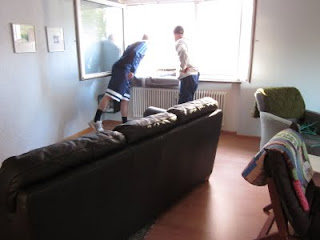 Self-Portrait, Henri Rousseau
Self-Portrait, Henri Rousseau
Art teacher blog number 2.
I've often been convinced that if I can get someone in an art museum with me, I can get them hooked on art. That's not to say I'm so amazing, but rather that the real thing + a little bit of demystification is so amazing. Seriously, if you haven't been to a museum, I wish I could explain to you what it's like to actually stand in front of a Van Gogh or Seurat's Sunday Afternoon or to walk all the way around a Rodin sculpture. Or how you can stand in front of a Rothko color field painting and sort of "walk into" it...
There are so many great museums and galleries in NYC, but time and money limitations tend to prevail. I've picked one each time I've visited. I got to see the Met the last time I was there, so this time I picked the MoMA.
Sometimes people assume I could stay in a museum all day. In reality I can only do about an hour or hour and a half. Saturation sets in. Imagine going to a huge buffet and trying to take a full portion (or even a sample size) of every dish offered. All those fabulous dishes get lost to your enjoyment by being stuffed. Similar for me at a museum.
Therefore, I have a game plan. :) I pick up a map, look for key artworks or artists that I know I enjoy (or eras, or something that limits me) and start there first. Any other sections of the museum I get to then become dessert. In each gallery, I generally scan the room and pick something that really grabs my attention for some reason, go in closer and spend some time really looking at it. Some works are pieces or artists I've long anticipated seeing in person, and others are these great surprises.
Someplace like the MoMA has tons of really well-known pieces - the kind that fill up standard art history books, art classroom print sets, art-themed merchandise, advertisements and spin-offs. Sometimes the real things ends up being far greater than you thought, and other times its almost disappointing - the legend is larger than life.
Here's an example:
The Persistance of Memory by Salvador Dali

He's fascinating to me - as he is to many - making his images from dreams and memories, influenced by Freudian Psychology and the subconscious. He's a surrealist, and looking at his work gives a person a clear idea of surrealism without further explanation. Sometimes his work makes me shudder a bit. It's usually the ants crawling on things that gets me. (I had my own recurring dream as a child involving ants - definitely hits a strong creepy chord for me!) Having used large prints of this painting in my classrooms, I was surprised to see how small it was. Really surprised. (Much like the reaction most people have to seeing the real Mona Lisa - "That's it?") It's not so creepy to me small and behind glass (sadly really well known works often end up behind glass for safety). Still a great piece - just small.
And then others are everything I hope them to be. The
Migration Series by Jacob Lawrence is another series of work I've admired.
 In the North the Negro had better educational facilities
In the North the Negro had better educational facilities And the migrants kept coming
And the migrants kept comingThese too were smaller than I realized, but getting to see them hang together was fabulous! The narrative/instructive lines were underneath each panel, and I could experience the story in its complicated reality - ironically because Jacob Lawrence painted each panel simply and used only short lines of text. (to see more panels and read the texts,
click here)
My surprise enjoyment piece was this one by Henri Rousseau,
Sleeping Gypsy

I've seen prints of it so many times in art education resources (it tends to be really intriguing to young students), but it's never been a standout for me. For some reason when I walked into the gallery where it hung (in this case far larger than I had imagined) it drew me in and I thoroughly enjoyed it. I think the size was a big part of it. Suddenly the lion and the gypsy both took on life and the colors had a sort of ethereal light - kind of like I stepped into the middle of a great story. It really stirs my imagination.
When I came home I did a little research because I really didn't know much about Rousseau or this painting. Turns out he was quite a character. He taught himself to paint and pronounced himself one of the great "realists" of his time. People probably snickered a bit when he made the statement because there's not much about how he paints that closely resembles reality. You know how in the first round of American Idol people who can't carry a tune walk in convinced they sing beautifully? It would have been a little bit like that to the educated art world at the time. He even told Picasso (who, whether one likes his work or not, had a broad and significant influence on the entire world of western art) that they were both the great masters of their time. It was a bold statement, and yet Picasso accepted him as a peer. Rousseau just kept painting and painting, hanging out with the big painters of his time, and some of the pieces captured something that has lingered long after his death.
I don't think the art academies of the day would have imagined that his work would show up as a standard in textbooks. It makes me think about how the world of art works and how artists work. One could say it proves the fickleness of the art establishment that the person most loudly declaring themselves to be an artist who knows the right people is eventually deemed great. But I see in him something a little different that speaks to the individual struggle for an artist. He had a tremendous faith in what he was endeavoring to do, and he was not intimidated by the status of others. I think most artists perpetually wonder if it's in them to make something great, if they're "good enough", if they can call themselves peers with other artists. There's a book I always recommend called
Art & Fear that talks about all the fears that keep artists from working. When I look at this painting from now on, I'm going to think about working fearlessly, about having a bit of Rousseau's audacity. I picked up a postcard of it. I think I'll have to pin it on my easel.











































